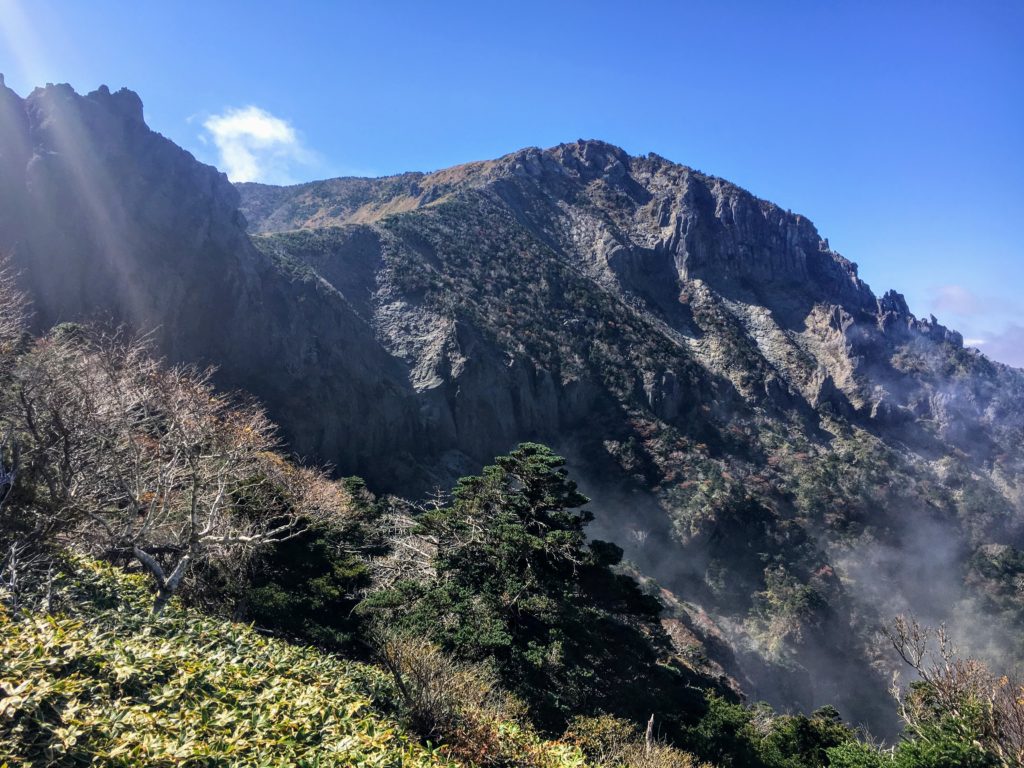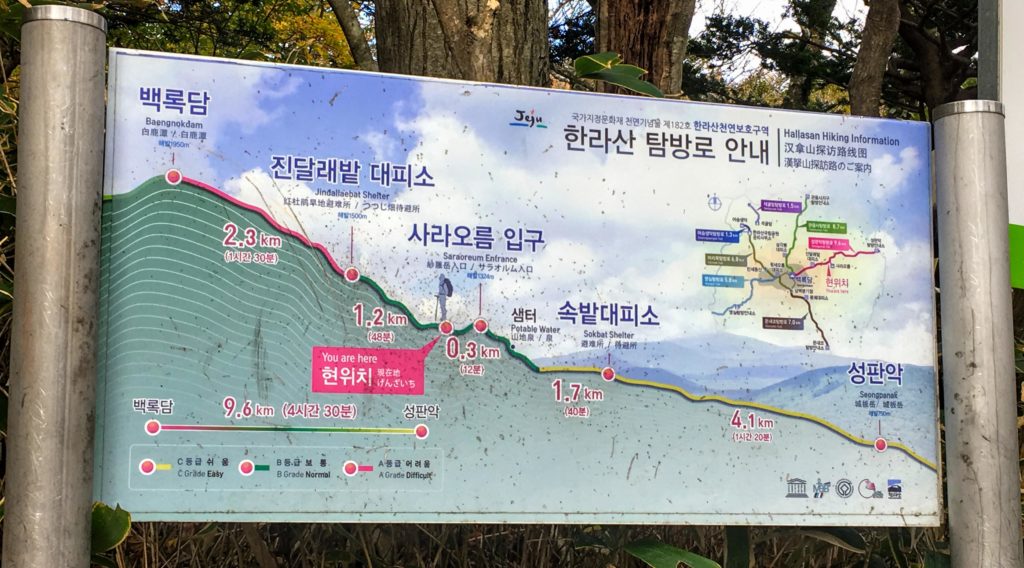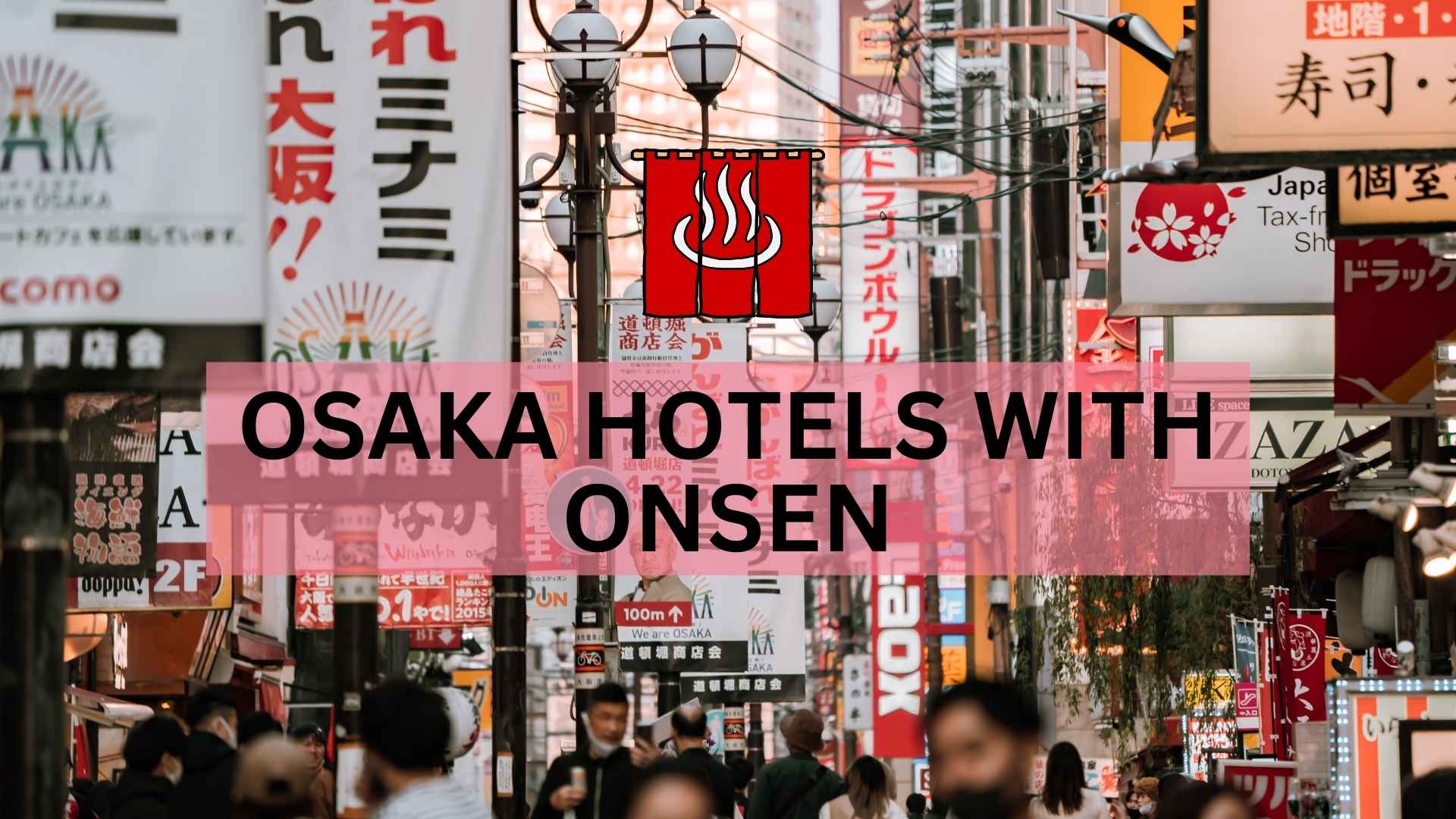Hallasan Mountain is the highest point in South Korea, located off the southern coast. Hallasan’s volcanic activity millions of years ago is what created its home, Jeju Island. It now stands tall and dormant at the heart of Jeju. The summit of the mountain is encompassed by a national park, and the entire area is recognized as a UNESCO World Natural Heritage Site.
Five hiking trails go up Mt. Hallasan to the upper crater, but only two trails reach the very summit – the top of South Korea. The best trail to hike Hallasan is a combination of these two hiking trails for a number of reasons listed below. It’s an experience you won’t regret!

Four Main Hallasan Hiking Trails
If you look at a map of Hallasan National Park, there are five Hallasan hiking trails that run up to its crater. Note that only two of these trails actually reach the summit.
- Seongpanak Trail – 9.7 km
- Gwanemusa Trail – 8.7 km
- Eorimok Trail – 4.7 km
- Yeongsil Trail – 3.7 km
- Donnaeko Trail – 9.6 km

Hallasan Hiking Trail Map – Source Wikipedia
The Best Trail to Hike Hallasan Mountain Summit?
Answer: Seongpanak Trail + Gwaneumsa Trail
The Seongpanak Trail is the best Hallasan hiking trail to go up for most hikers. It’s the longest Hallasan hiking trail at 9.7km, but it starts gradual and stays only slightly inclined (plus some stairs) for the majority of it. The steepest part of the Seongpanak trail is near the summit, where you just have to take many flights of wooden stairs. Overall, not too bad!
The best Hallasan hiking trail to take down from the summit is the Gwaneumsa Trail. The Gwaneumsa Trail connects to Seongpanak at Hallasan’s summit, so it’s easy to navigate hiking up Seongpanak and down Gwaneumsa Trail. This trail is 8.7km long, for a combined 18.4 km day of hiking Mt. Hallasan.
For me to hike Hallasan up the Seongpanak Trail took 3 hours, and down via the Gwaneumsa Trail took me 2.5 hours. Expect this exact Hallasan hike trail to take about 6-8 hours, including time for resting at the summit.

The Second Best Trail to Hike Hallasan?
Answer: Gwaneumsa Trail Up and Down
If you don’t mind hiking Hallsan via the same trail up and down, then I recommend taking the Gwaneumsa Trail to do exactly that. The Gwaneumsa Trail is known as the most scenic out of the five options. Walking over lava-rock rivers and down into ravines will remind you at every step that you are hiking Hallasan, a UNESCO Natural Heritage Site.
The only thing to note is the Gwaneumsa Trail is much more difficult to go up than the Seongpanak Trail, so going up and down will take much more time. Expect an 8-9 hour day of hiking Hallasan if you decide to take the Gwaneumsa Trail up and down.
Note: If you’re staying South of Jeju Island, the popular Hallasan hiking trails are to the Donnaeko Trail and the Yeongsil Trail. You can combine these two in one Hallasan hike, by going up the Donnaeko Trail and down the Yeongsil Trail too. These two trails will just take hikers around the top crater of Mt. Hallasan, and not to the summit of it.

Important Safety Things To Know Before Hiking Hallasan
When I visited Hallasan in October 2019, there was no place to stock up on water or food along the Hallasan hiking trails. A number of buildings were under construction along the Seongpanak Trail to provide more amenities in the future. For now though, bring everything with you from Jeju city before you start hiking Hallasan.
The weather at Mt. Hallasan can change dramatically when at higher elevations. Be prepared for rain and cold even in the heart of summer. Bring sunscreen to protect from the UV rays too, for the Mt. Hallasan summit when you’re out of the tree line.
After a day of rain or when the clouds are thick on the mountain, many rocks are slippery. I recommend wearing hiking boots to help mitigate against falling or misstepping on the slippery lava rocks while hiking Hallasan.

Hiking Hallasan Turnaround Times
A strict turnaround time is in place for all Hallasan hiking trails. You cannot continue your Hallasan hike if you haven’t reached the designated shelter before a certain time (dependent on the time of the year).
For the Seongpanak Trail, if you have not reached Jinailaebat Shelter by 1:00pm in the summer, 12:00pm in the winter, and 12:30pm in the fall, you’ll have to turn back without reaching the summit.
A strict descending time from the Mt. Hallasan summit is also in place. In the summer, start descending from the summit by 2:30pm. In the winter, by 1:30pm, and in the spring and fall, by 2:00pm.

Hiking Hallasan Packing List
Tip: Bring water in a reusable water bottle. There are some springs along the Seongpanak Trail where you can refill (but don’t rely on this because they are easy to miss). Bring at least 1.5 liters of water per person.
- Lunch and Snacks (you can’t buy anything on the Hallasan hiking trails)
- Light rain jacket
- Hiking boots are recommended
- Trekking poles (optional)
- Sunscreen
- Picnic mat (optional)
- First Aid Kit

Starting Your Hallasan Hike: Getting to the Seongpanak Trail
From Jeju City Center, near Jeju City Hall, there are two direct busses that will take you to the Seongpanak Trailhead for the Hallasan hike: bus 181 is an express bus, and 281 is the local bus.
Before 8-8:30 in the morning, the time it takes for both of these busses to reach the trailhead station is about the same (just under 30 mins).
Tip: To navigate Jeju Island, check out the app Kakao Maps for near-accurate estimates on when busses will be arriving and departing.

On the Seongpanak Trail: Hiking Hallasan
The reason why the Seongpanak Trail is the best Hallasan hiking trail is because it’s the easiest. Although a little endurance is necessary to make it up all 9.7km to the summit, most of the Seongpanak Trail is gentle slopes and wooden staircases.
There are two large shelters and rest areas, and there are several benches along the trail where you can break away for a breather too. Many locals brought picnic mats to lay out while they were having lunch or snacks along the Seongpanak trail.
Much of the start of the trail is covered in a rope-material carpet, which makes it easy to walk on compared to Gwaneumsa Trail’s slippery lava rocks.

Halfway Point: Seongpanak Trail Gets Steeper
Once the Seongpanak trail reaches the “normal” and “advanced” difficulty sections, it theoretically gets a bit steeper (see graphic below). There may be more staircases with fewer straightaways in between.
Near the end of the Seongpanak Trail, you reach a forest clearing where you’ll see a massive wooden staircase to the Hallasan summit. You’re basically at the top here!
I found that the view from the platforms along this staircase were some of the best of Jeju Island – better than the summit itself, so don’t shy away from taking breaks just before the top.

Mt. Hallasan Summit
The summit of Mt. Hallasan is mostly covered in wooden walkways. A commemorative rock lets you know that you’ve reached Hallasan’s summit, which you’ll have to wait a loooong time in line to take a picture with.
Peek down into the volcano’s crater, a grassy area off-limits to hikers. A beautiful lake sits in the middle, which changes colors and shapes depending on the season.

Right at the end of the Seongpanak trail, at the beginning of the summit platform, is where the crowds like to picnic. There are some walkways a little further down, towards the start of the Gwaneumsa Trail, where I was able to find some peace and quiet.


Hiking Down the Gwaneumsa Trail
Hope your knees are prepared for this brutal down-hill. The 8.7km Gwaneumsa Trail is mostly downhill without straightaways, and much of it is over rocky stairs. One difficult section close to the summit even has ropes to hold on to as you go down large stone steps.
Luckily the view on the Gwaneumsa Trail is amazing, starting with the razor-sharp cliffs that jut out from Hallasan’s summit, to suspension bridges over deep ravines. Especially in the autumn season, the fall foliage is in bright red and yellow bloom.
Tips for descending to make it easier on your knees: quicken your pace when you’re going down stairs so your knees don’t feel the full impact of each step. Take frequent breaks. Move down larger steps sideways and alternate sides.


Getting back to Jeju City from Gwaneumsa Trail
Bus 475 runs regularly from the road next to the Gwaneumsa Trail head. Take this bus to Jeju National University Station, a transit hub, then transfer to any of the other busses heading to Jeju City Center (212, 222, 232, 341, 342, 351, 352, and more).
Up for more hiking in South Korea? Try Baegundae Summit near Seoul!







